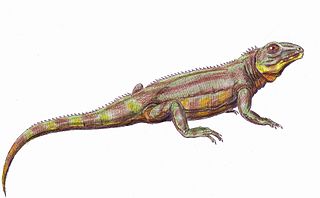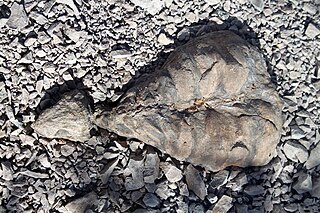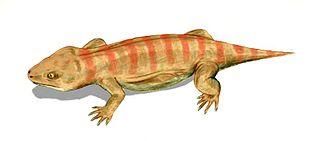
Millerettidae is an extinct family of parareptiles from the Middle Permian to the Late Permian period of South Africa. The millerettids were small insectivores and probably resembled modern lizards in appearance and lifestyle.

Milleretta is an extinct genus of millerettid parareptile from the Late Permian of South Africa. Fossils have been found in the Balfour Formation. Milleretta was a moderately sized, lizard-like animal, about 60 centimetres (24 in) in length. It was probably insectivorous. Its only known species is Milleretta rubidgei, making Milleretta a monospecific genus.

Captorhinidae is an extinct family of tetrapods, typically considered primitive reptiles, known from the late Carboniferous to the Late Permian. They had a cosmopolitan distribution across Pangea.

The Beaufort Group is the third of the main subdivisions of the Karoo Supergroup in South Africa. It is composed of a lower Adelaide Subgroup and an upper Tarkastad Subgroup. It follows conformably after the Ecca Group and unconformably underlies the Stormberg Group. Based on stratigraphic position, lithostratigraphic and biostratigraphic correlations, palynological analyses, and other means of geological dating, the Beaufort Group rocks are considered to range between Middle Permian (Wordian) to Early Triassic (Anisian) in age.

Procolophonidae is an extinct family of small, lizard-like parareptiles known from the Late Permian to Late Triassic that were distributed across Pangaea, having been reported from Europe, North America, China, South Africa, South America, Antarctica and Australia. The most primitive procolophonids were likely insectiovous or omnivorous, more derived members of the clade developed bicusped molars, and were likely herbivorous feeding on high fiber vegetation or durophagous omnivores. Many members of the group are noted for spines projecting from the quadratojugal bone of the skull, which likely served a defensive purpose as well as possibly also for display. At least some taxa were likely fossorial burrowers. While diverse during the Early and Middle Triassic, they had very low diversity during the Late Triassic, and were extinct by the beginning of the Jurassic.

Nyctiphruretus is an extinct genus of nyctiphruretid parareptile known from the Guadalupian series of European Russia.

Belebey is an extinct genus of bolosaurid ankyramorph parareptile containing species known from the latest Carboniferous (Gzhelian) or earliest Permian (Asselian) to Guadalupian stage of Europe and Asia.

Bolosaurus is an extinct genus of bolosaurid ankyramorph parareptile from the Cisuralian epoch of North Asia and North America.

Eunotosaurus is an extinct genus of amniote, possibly a close relative of turtles. Eunotosaurus lived in the late Middle Permian and fossils can be found in the Karoo Supergroup of South Africa. Eunotosaurus resided in the swamps of southern Africa. Its ribs were wide and flat, forming broad plates similar to a primitive turtle shell, and the vertebrae were nearly identical to those of some turtles. Accordingly, it is often considered as a possible transitional fossil between turtles and their prehistoric ancestors. However, it is possible that these turtle-like features evolved independently of the same features in turtles, since other anatomical studies and phylogenetic analyses suggest that Eunotosaurus may instead have been a parareptile, an early-diverging neodiapsid unrelated to turtles, or a synapsid.

Acleistorhinus (ah-kles-toe-RYE-nuss) is an extinct genus of parareptile known from the Early Permian of Oklahoma. It is notable for being the earliest known anapsid reptile yet discovered. The morphology of the lower temporal fenestra of the skull of Acleistorhinus bears a superficial resemblance to that seen in early synapsids, a result of convergent evolution. Only a single species, A. pteroticus, is known, and it is classified in the Family Acleistorhinidae, along with Colobomycter.

Owenetta is an extinct genus of owenettid procolophonian parareptile. Fossils have been found from the Beaufort Group in the Karoo Basin of South Africa. Although most procolophonians lived during the Triassic, Owenetta existed during the Wuchiapingian and Changhsingian stages of the Late Permian as well as the early Induan stage of the Early Triassic. It is the type genus of the family Owenettidae, and can be distinguished from other related taxa in that the posterior portion of the supratemporal bears a lateral notch and that the pineal foramen is surrounded by a depressed parietal surface on the skull table.

Owenettidae is an extinct family of procolophonian parareptiles. Fossils have been found primarily from Africa and Madagascar, with one genus present from South America. It is the sister taxon to the family Procolophonidae. Modesto and Damiani (2007) defined Owenettidae as a stem-based group including Owenetta rubidgei and all species closely related to it than to Procolophon trigoniceps.

Procolophonoidea is an extinct superfamily of procolophonian parareptiles. Members were characteristically small, stocky, and lizard-like in appearance. Fossils have been found worldwide from many continents including Antarctica. The first members appeared during the Late Permian in the Karoo Basin of South Africa.

Millerosaurus is an extinct genus of millerettid parareptile from the Late Permian of South Africa. It was a small animal which reached a length of 30 cm. Unlike many other parareptiles, it had holes (fenestrae) behind the eyesockets in the skull. It had a slabsided body, a long tail, and a narrow but triangular skull with large eyes, and is thought to have been insectivorous.
Milleropsis is an extinct genus of millerettid parareptile from the Late Permian of South Africa.
Australothyris is an extinct genus of basal procolophonomorph parareptile known from the Middle Permian of Tapinocephalus Assemblage Zone, South Africa. The type and only known species is Australothyris smithi. As the most basal member of Procolophonomorpha, Australothyris helped to contextualize the origin of this major parareptile subgroup. It has been used to support the hypotheses that procolophonomorphs originated in Gondwana and ancestrally possess temporal fenestrae, due to its large and fully enclosed temporal fenestra and South African heritage. It also possessed several unique features, including a high tooth number, long postfrontal, small interpterygoid vacuity, and a specialized interaction between the stapes and quadrate.

The Abrahamskraal Formation is a geological formation and is found in numerous localities in the Northern Cape, Western Cape, and the Eastern Cape of South Africa. It is the lowermost formation of the Adelaide Subgroup of the Beaufort Group, a major geological group that forms part of the greater Karoo Supergroup. It represents the first fully terrestrial geological deposits of the Karoo Basin. Outcrops of the Abrahamskraal Formation are found from the small town Middelpos in its westernmost localities, then around Sutherland, the Moordenaarskaroo north of Laingsburg, Williston, Fraserburg, Leeu-Gamka, Loxton, and Victoria West in the Western Cape and Northern Cape. In the Eastern Cape outcrops are known from Rietbron, north of Klipplaat and Grahamstown, and also southwest of East London.

Ankyramorpha is an extinct clade of procolophonomorph parareptiles which lived between the early Cisuralian epoch and the latest Triassic period of Africa, Antarctica, Asia, Australia, Europe, North America and South America.

Procolophoninae is an extinct subfamily of procolophonid parareptiles from the late Early Triassic to the early Middle Triassic of Africa, Antarctica, Asia, Europe and South America. Currently, the oldest-known procolophonine is Procolophon from the earliest Olenekian stage.
Barasaurus is an extinct genus of owenettid procolophonoid parareptile known from the Late Permian and Early Triassic of Madagascar. It contains a single species, Barasaurus besairiei.




















